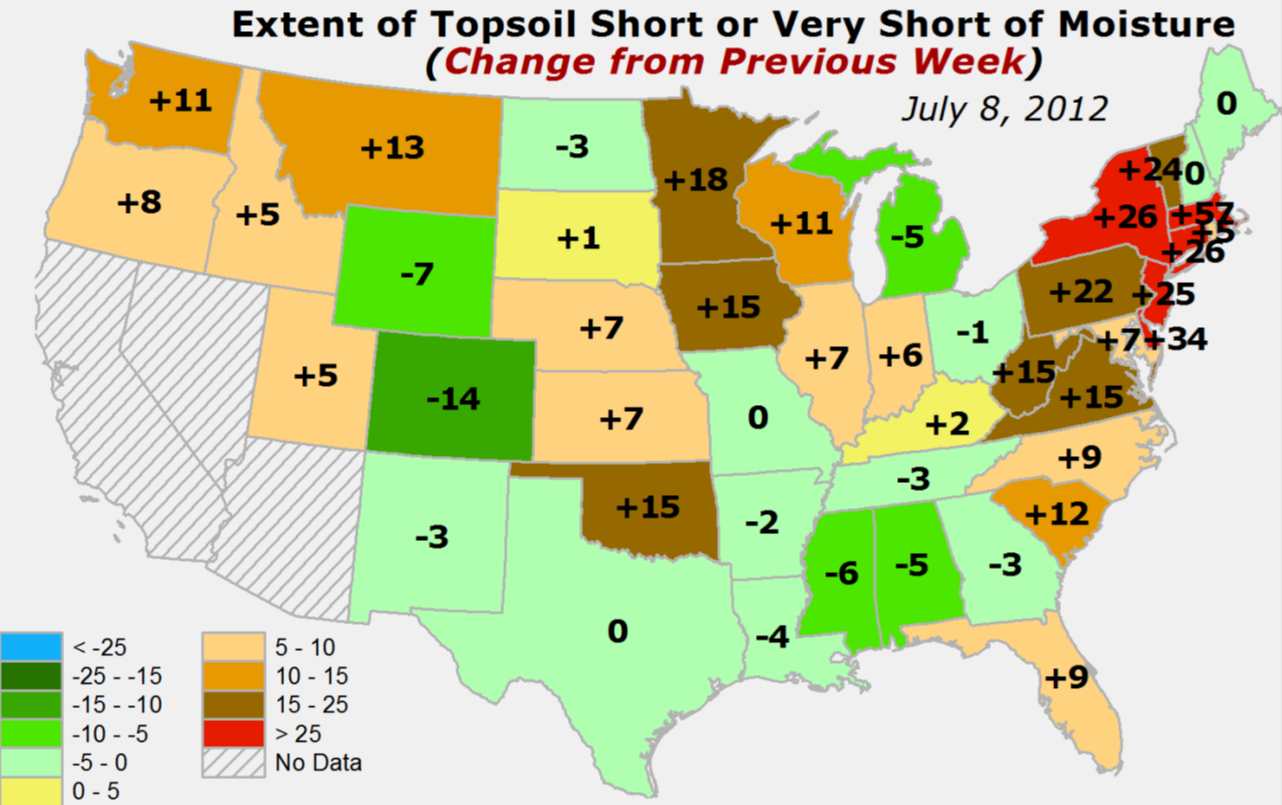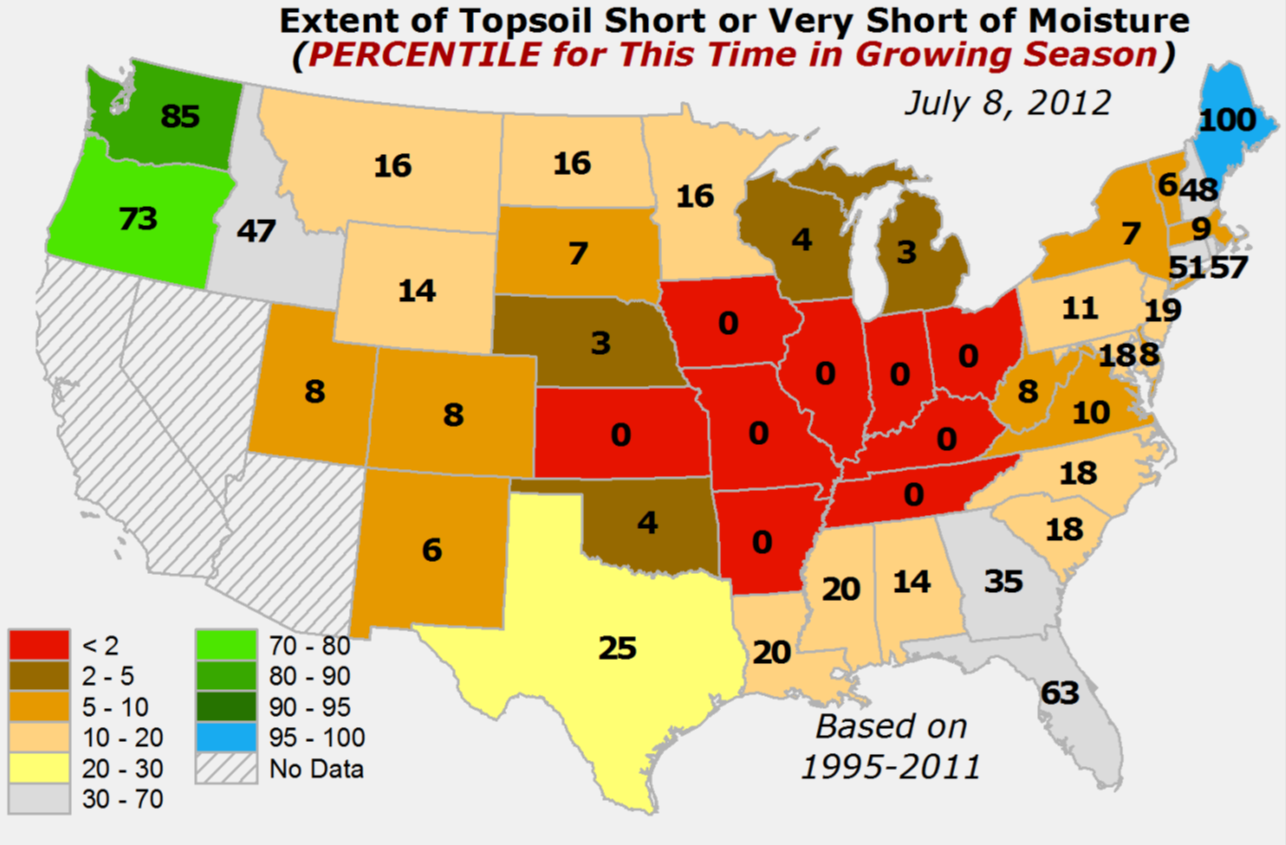Ticker for July 10, 2012
MESONET TICKER ... MESONET TICKER ... MESONET TICKER ... MESONET TICKER ...
July 10, 2012 July 10, 2012 July 10, 2012 July 10, 2012
We call it maize, you call it expensive
Drought continues to flourish in Oklahoma, even as rain falls in localized areas.
Here is what the USDA's National Agricultural Statistics Service folks said in
their latest Oklahoma Crop report.
The drought continued to develop across the state under hot and dry
conditions the past week. Over 61 percent of the state was in a moderate
to extreme drought per the July 3rd Drought Monitor. Little to no rain fell
in western and central Oklahoma, with a few isolated areas of heavier
rainfall in eastern Oklahoma and the Panhandle: Hooker recorded 2.5
inches of rain in the Panhandle and McAlester received two inches.
Average temperatures were in the mid 80?s and highs continued to top
100 degrees. All crops suffered from the developing drought, though
dryland crops fared worse with the lack of precipitation the past few
weeks. Livestock conditions declined somewhat, as the heat took its toll
on the animals, as well as the available pasture and stock ponds. Grasses
were burning up and hay production was limited. Topsoil moisture
conditions were rated mostly short to very short, with only six percent
rated adequate. Subsoil moisture conditions were rated short to very
short, with 14 percent rated adequate.
The drought is much worse in other parts of the country, especially up in the
important corn growing areas of the Midwest. You will start to see this
reflected in the price of food and other goods as the drought continues to
damage crops.
Here are some other sobering statistics from across the country. I'll try to
throw a few national maps in there as well.
Topsoils
* Topsoils covering almost exactly 70% of the 44 reporting states are short or
very short of moisture
Rangeland/Pastures
* Now 50% of pastures and ranges are in poor or very poor condition; this is
exceeded only by the 51% reported on both August 13 and 20, 2006...and the
52% reported September 15, 2002.
* The 7% of the contiguous states that slid into poor or very poor condition is
topped only by the 9% that similarly deteriorated last week
* Poor and very poor conditions expanded into 23% of the contiguous states in
the last 4 weeks, a record. In fact...
* Such conditions expanded into 22% more of the contiguous states in the last 3
weeks; more than any 4-week period on record
* For this time of year, late June to late July, the 50% coverage is well ahead
of the previous maximum - 41% July 16, 2006
* Looking just at very poor conditions, the numbers aren't quite so remarkable;
now 21% of the nation is in very poor condition, which has been exceeded in
33 of the 452 weeks on record...though the record is not too much higher
(26%, September 15 & 22, 2002)
Zounds! I know I talk all the time about drought creeping up and therefore
being tough to track real-time, but this sure happened in a hurry! Now 94% of
Oklahoma topsoil is rated short/very short. Again, remember the rains we've
gotten recently helping here and there.

Here is the one-week change, a 15% slide for Oklahoma.

For much of corn country and the rest of the Great Plains, this is some of the
driest topsoil conditions experienced since 1995. The zeroes indicate it is
the driest. For Oklahoma, it darned near is.

There are a lot of whopping nasty droughts in that time frame. Nothing like
the Dust Bowl, but several short-yet-catastrophic episodes, like the 1996,
2001-02, 2005-06 and 2010-11 droughts.
The pasture conditions could be worse.

But for this time of year, they ARE worse.

But that's been my point the last couple of months. The dry conditions are
ahead of schedule with two more months of "normally" dry weather to go. This
current rain is a big help in some parts. Like a lot of summer rains, however,
this one is true to form ... too localized thus far.

At least the rain and cooler weather will slow the advance and intensification
of drought for Oklahoma, but advance and intensify it will when the heat comes
back.
Forget stocks, bonds, or precious metals. Invest in Doritos.
Gary McManus
Associate State Climatologist
Oklahoma Climatological Survey
(405) 325-2253
gmcmanus@mesonet.org
July 10 in Mesonet History
| Record | Value | Station | Year |
|---|---|---|---|
| Maximum Temperature | 114°F | FREE | 2009 |
| Minimum Temperature | 55°F | EVAX | 2024 |
| Maximum Rainfall | 4.44″ | MINC | 1996 |
Mesonet records begin in 1994.
Search by Date
If you're a bit off, don't worry, because just like horseshoes, “almost” counts on the Ticker website!